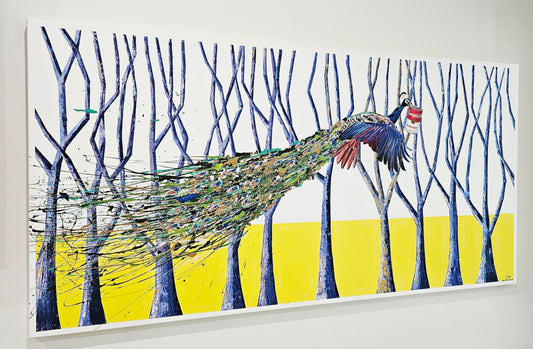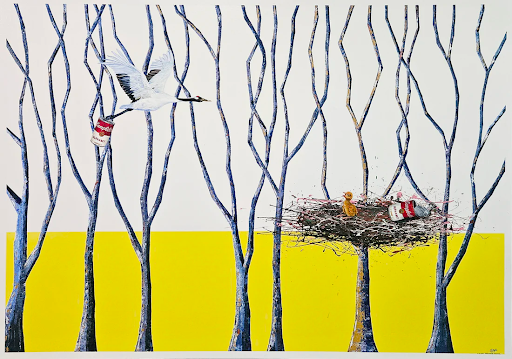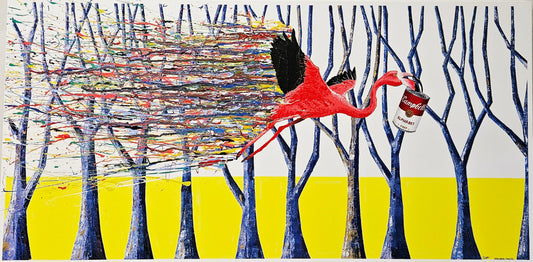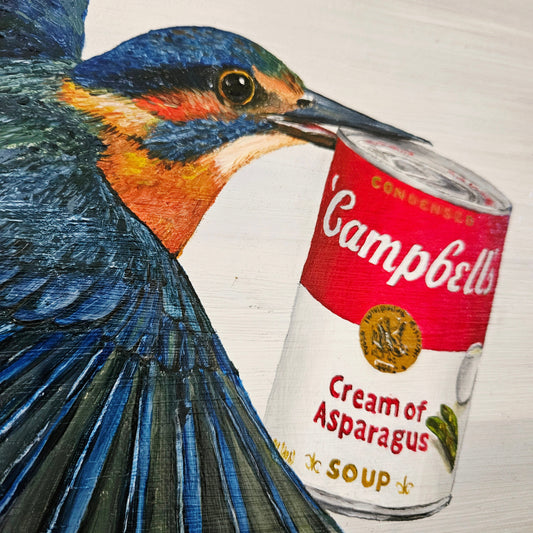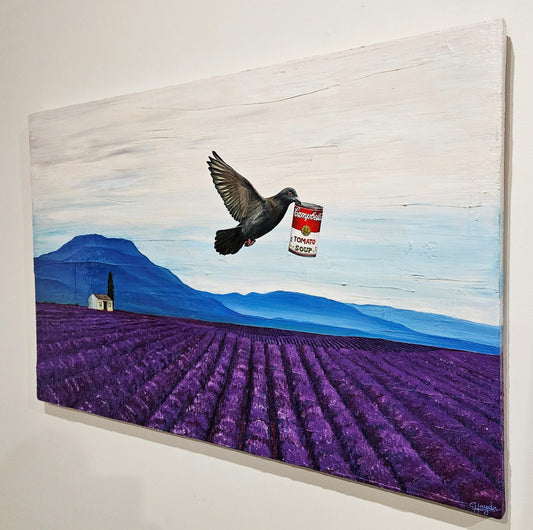The Search – Surreal Owl Painting With Campbell’s Soup by Englander Porter

Explore the symbolism of “The Search”, a surreal oil painting featuring an owl and Campbell’s soup. Discover how Englander Porter blends nostalgia, nature, and commentary on consumerism in his new soup series.
A Flight Through Symbolism: “The Search” and the Power of the Surreal
Amid the grayscale void of a textured sky, a barn owl cuts through the canvas in frozen flight, not clutching prey, but a can of Campbell’s Cream of Potato soup. This is The Search, one of the most evocative and unexpected pieces by Australian artist Haydn Englander-Porter. It’s a visual riddle in oil on canvas, sitting at the intersection of realism and absurdism, nostalgia and commentary, nature and commercialism.
Englander-Porter’s work taps into the absurdities of contemporary life without sacrificing visual beauty. In The Search, every feather is rendered with photographic precision, every ripple of the owl’s wings hinting at movement. And yet the owl’s burden a can of mass-produced comfort food, throws us into an existential spiral. What is it searching for? Why soup? Why now?
As one of the unique pieces in Englander Porter’s latest soup-themed series, The Search sets the tone for a broader artistic exploration: how everyday objects, repurposed through art, become vessels for deeper meaning. This series is anything but repetitive. It’s bold, layered, and, perhaps most strikingly, deeply human.
Let’s dive into what makes The Search such a remarkable statement, and why this entire collection is shaping up to be a defining moment in modern Australian surrealism.
The Painting at a Glance: Dissecting “The Search”
Medium: Oil on Canvas
Style: Surreal Realism with Monochromatic Palette
Key Motifs: Barn Owl, Campbell’s Cream of Potato Soup, Abstract Sky
From a purely visual standpoint, The Search is haunting. The barn owl, often associated with insight, nocturnal surveillance, and ancient wisdom, is depicted in sharp detail and lifelike accuracy. Englander-Porter’s use of chiaroscuro and anatomical accuracy brings a raw intensity to the bird, which appears mid-flight against a flat, grey expanse.
But this owl isn’t chasing rodents. Instead, it clutches a can of Campbell’s soup, a cultural artefact immortalised by Andy Warhol, here given new wings. It’s not just surreal; it’s satirical, nostalgic, and oddly relatable.
The scene is empty and vast, evoking feelings of isolation or endless searching, yet the presence of the soup can anchor us. It’s familiar. It’s mass-produced. It’s what’s in the cupboard when life feels uncertain. In this way, the painting becomes both critique and comfort, humour and hunger, freedom and weight.
Owls and Soup: The Power of Juxtaposition
Why pair an apex nocturnal predator with a humble grocery item?
That’s precisely the brilliance of The Search. Englander-Porter doesn’t merely aim to shock or amuse. He invites viewers to confront the absurd contradictions of modern life: nature versus nurture, instinct versus indulgence, wildness versus branding.
Owls are known for precision hunting, silent flight, and a solitary mystique. Soup cans, on the other hand, are factory-made, affordable and convenient. Their presence in the owl’s talons raises compelling questions about what we value, what we carry, and what we're truly chasing.
Is the owl hunting nourishment, or is it delivering a symbol of comfort in uncertain times? Is it escaping the trappings of consumer culture or bound by them? Englander-Porter leaves interpretation open, and that’s what gives The Search its lasting power.
The Soup Series:
The Search is just one of a series of oil paintings in Englander Porter’s soup series, each crafted with its own distinct personality and visual language. While all feature soup cans in unexpected contexts, none feel formulaic. Each canvas is an exploration of symbolism, satire, and style.
Some paintings lean into absurdism, while others use realism as a mask for quiet rebellion. Certain pieces are playful, almost humorous, while others carry an emotional undercurrent that’s difficult to articulate.
Together, the collection forms a meta-narrative on human longing, how we assign meaning to objects, how we commodify culture, and how art can reclaim the familiar to tell unfamiliar stories.
And in a time when mass production and digital content saturate daily life, these hand-painted, physical canvases feel refreshingly tactile. They’re not just paintings; they’re moments, meditations, and provocations, begging to be seen, questioned, and discussed.
Who Is Englander-Porter?
Haydn Englander-Porter is no stranger to Australian art lovers. Based on the Sunshine Coast, his work is characterised by an ongoing dialogue between abstraction and realism, as well as a blend of personal experience and universal themes. He paints with technical precision but resists easy categorisation.
In earlier series, Englander-Porter explored themes of nature, emotion, and human form, often with a hint of mysticism or mood. But this soup series marks a fascinating evolution. Here, humour and critique are baked into the brushstrokes. Nostalgia takes on wings. And each canvas feels like a contemporary fable.
What sets him apart is not just technique, but voice. He doesn’t preach, he plays. He doesn’t dictate meaning; he invites you to discover it.
Englander-Porter’s works have appeared in homes, galleries, and global collections, but this new series adds a layer of cultural conversation that’s difficult to ignore. As he puts it, “These paintings are more than objects. They’re questions.”
Soup as Cultural Commentary
Let’s talk about the soup.
For decades, Campbell’s soup has been emblematic of both home comfort and mass commodification. It’s cheap, warm, and easy, a mainstay in family kitchens across the Western world. However, thanks to Warhol and pop art, it has also become an icon of commercialism, critique, and the intersection of high and low culture.
Englander-Porter picks up this legacy and twists it. He doesn’t just reframe soup as art; he gives it purpose. In The Search, it becomes the object of pursuit. In other words, it becomes the burden, the offering, or even the protagonist.
By repeatedly centring soup in such emotionally varied and visually complex environments, Englander-Porter challenges us to reconsider how we interact with branded culture. What happens when you strip a commercial product of its context and place it in nature, in myth, in isolation?
You get laughter. You get discomfort. You get meaning.
From Canvas to Collection: Why These Paintings Matter
As individual works, these soup paintings are beautiful, bold, and bizarre. As a collection, they’re unforgettable. And as part of a home or gallery space, they’re guaranteed conversation starters.
These aren’t just decorative artworks, they’re layered experiences. Hang one on your wall, and it doesn't simply "go with the couch." It provokes. It lingers. It asks you daily, 'What are you searching for?'
That’s what makes owning a piece of this series special. Each canvas is an original, no prints, no reproductions, just pure, hand-painted provocation from one of Australia’s most curious artistic voices.
Why Collectors Should Act Fast
With only 32 paintings available, each uniquely styled and composed, this series won’t be around for long. Early collectors have already begun acquiring works, recognising their artistic and cultural value.
Whether you're an art investor, a gallery curator, or someone looking for a singular piece to add depth to your personal space, now is the time to explore the whole series on the Englander Porter Art website.
From The Search to others still unrevealed, each painting is a one-of-a-kind meditation on life, longing, and legacy.
What Are You Searching For?
In an age of noise, algorithms, and manufactured meaning, The Search stops us in our tracks. It reminds us that not everything must be rational. That beauty can come from contradiction. That sometimes, an owl with soup is more profound than we realise.
Haydn Englander-Porter has taken a mundane item and elevated it, not just visually, but conceptually. Through this collection, he asks us to examine what we carry, what we consume, and what defines value in a distracted world.
So, whether you're staring at The Search or another canvas in this brilliant series, the question is the same:
What are you searching for?



